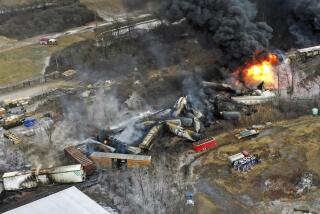BART workers were responsible for their own safety, NTSB says
WALNUT CREEK, Calif. -- Two Bay Area Rapid Transit workers killed Saturday during an employee strike were operating under employer rules that made them responsible for their own safety, a federal transportation investigator said Tuesday.
James Southworth, who is leading the probe of the BART accident for the National Transportation Safety Board, said the men who died on the second day of the strike were inspecting tracks under a procedure BART calls “simple approval.”
“The responsibility for their safety is on themselves,” Southworth said.
He said the employees obtain approval from headquarters to be on the tracks, but the protocol does not call for giving them any warning of approaching trains, nor does it require train operators to slow down.
“No, they do not get warning,” he said of the track workers. “They are to expect the train at any direction and at any time.”
Dispatch does inform train drivers of their presence, however.
One worker is supposed to act as a lookout and determine “how and where to move into the clear” when a train comes along, Southworth said. He said the NTSB will examine the procedure as part of its investigation of the accident.
“We are looking at all rules and all operating practices,” he said.
BART was preparing managers to run trains in the event the strike was protracted, and the person running the train that killed the workers was one of two trainees on board.
Southworth said both trainees “shared time in the seat” operating the train while an experienced trainer stood behind them. He said the train was also carrying three others who were not involved in the training exercise.
He said the NTSB has determined that the air horn which the train sounded as it approached the workers, the train lights and its brakes were “operable, without any defects.”
Southworth said he has not yet determined the interval of time between the sound of the horn and the impact. He said at a Monday news conference that the train was moving 60 mph to 70 mph when an emergency stop was executed.
BART train operators said in interviews that a train traveling at that speed cannot come to a complete stop in less than about a quarter of a mile.
The two workers who died were Laurence Daniels, 66, who worked for a private contractor, and Christopher Sheppard, 58, a BART employee doing his regular job. BART has said both were highly experienced.
Train operators say it can be difficult for someone on a track to hear an approaching train. A widow of a BART worker who was killed on a track in 2008 said her late husband called a BART train “a silent killer.”
The loss of two lives helped spur the unions and BART management to return to the negotiating table and settle the strike Monday. BART trains resumed running Tuesday.
BART board President Tom Radulovich said the accident “sobered everybody up.”
“I was actually with one of the union leaders when we heard the news,” he said in a television interview the day after the accident, “and it just struck us we need to end this.”
ALSO:
LAX dry-ice bombs: Second suspect due in court Tuesday
Death toll in Fontana crash rises to three, including 2-year-old girlFamily of man who died in Riverside County incident ‘wants answers’
Twitter: @mauradolan
maura.dolan@latimes.com
More to Read
Sign up for Essential California
The most important California stories and recommendations in your inbox every morning.
You may occasionally receive promotional content from the Los Angeles Times.










